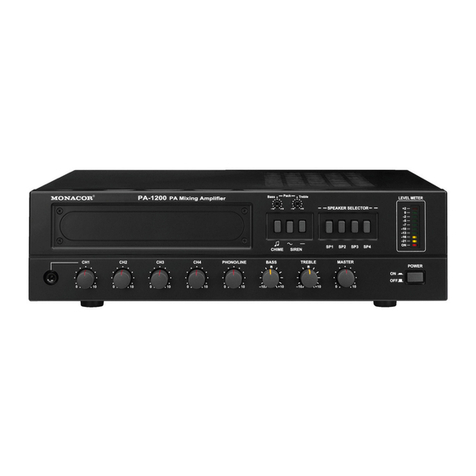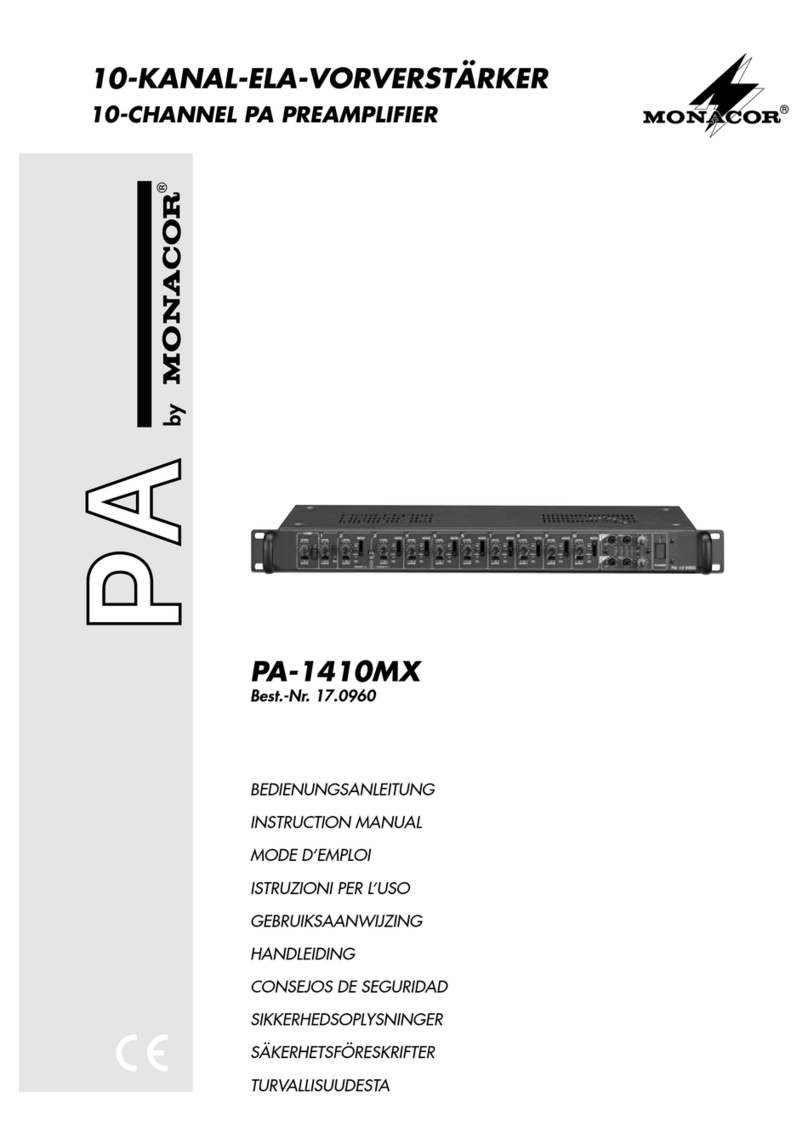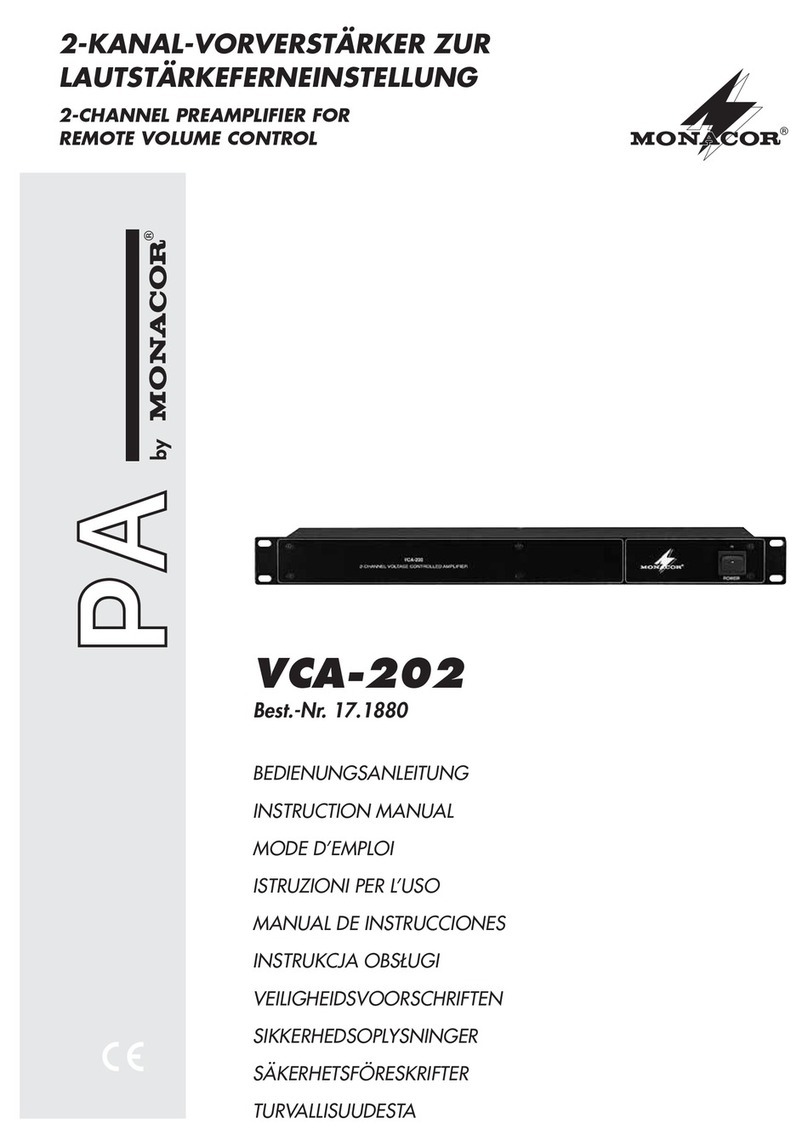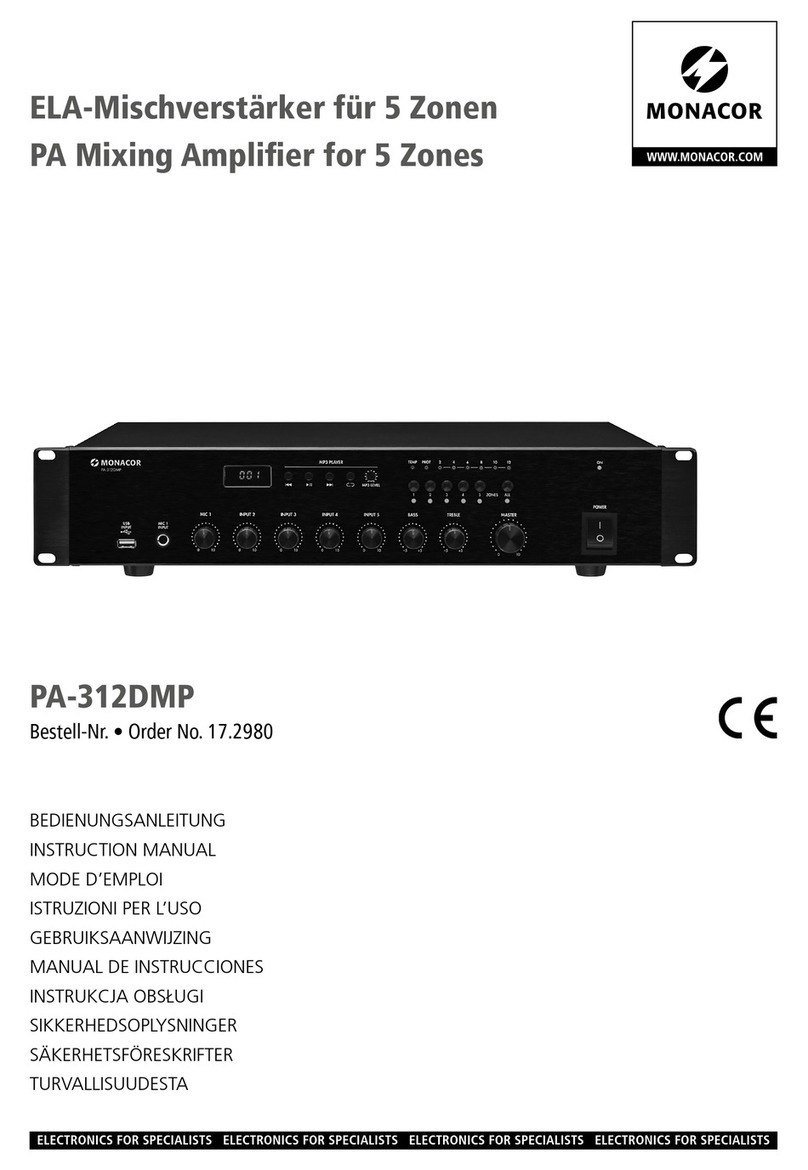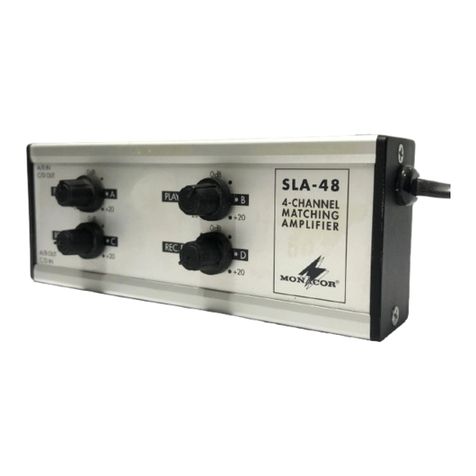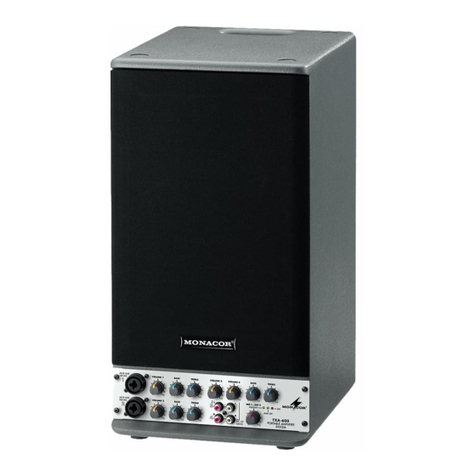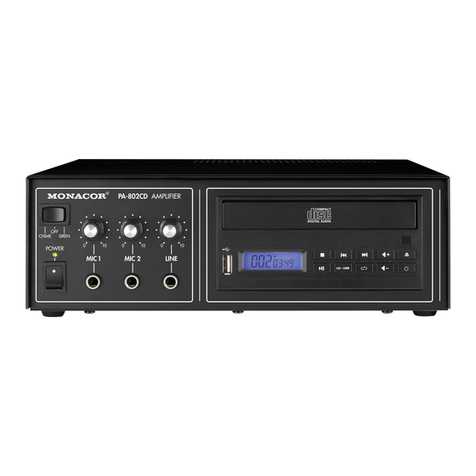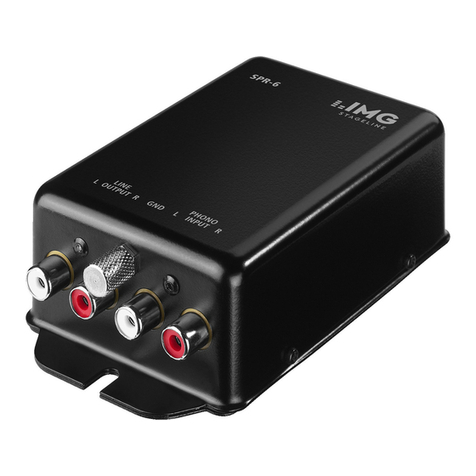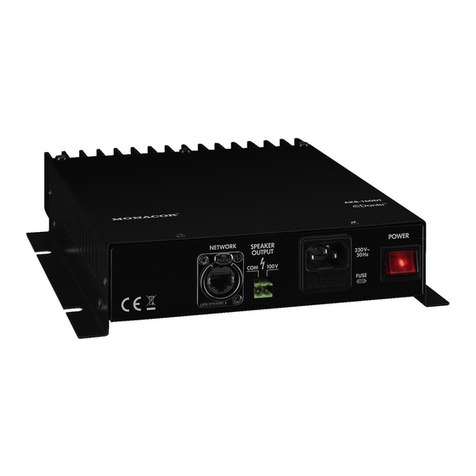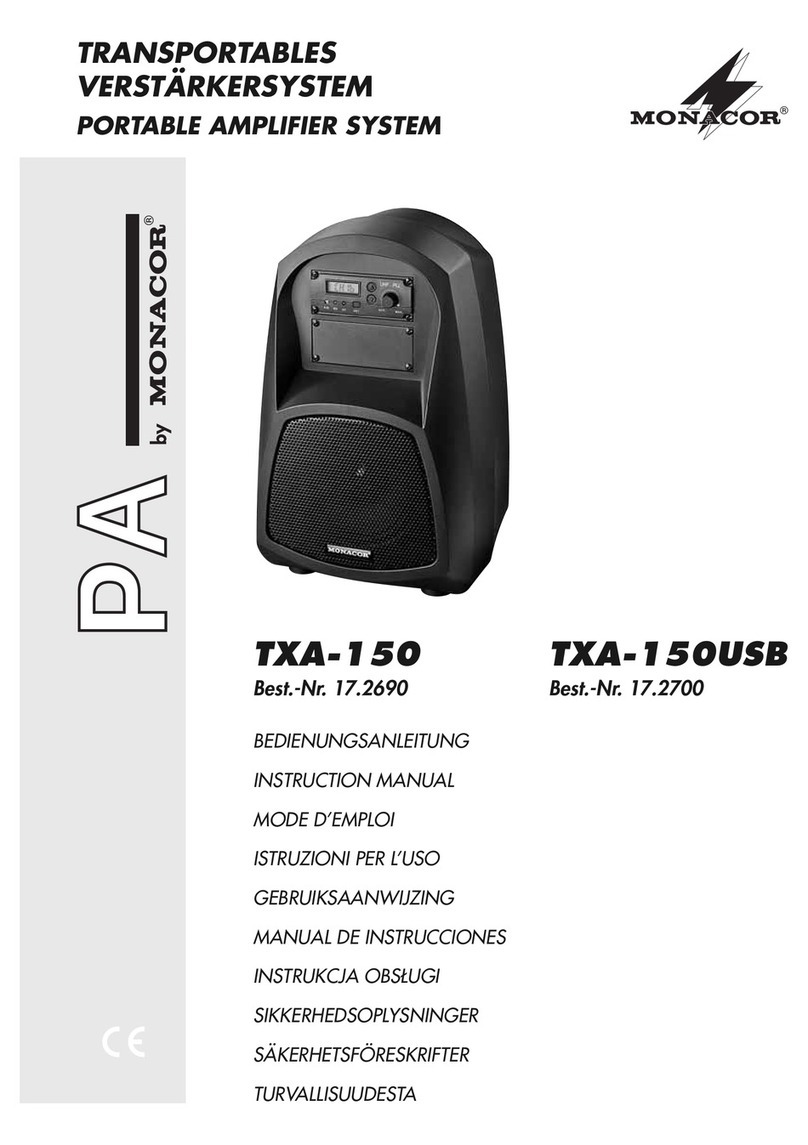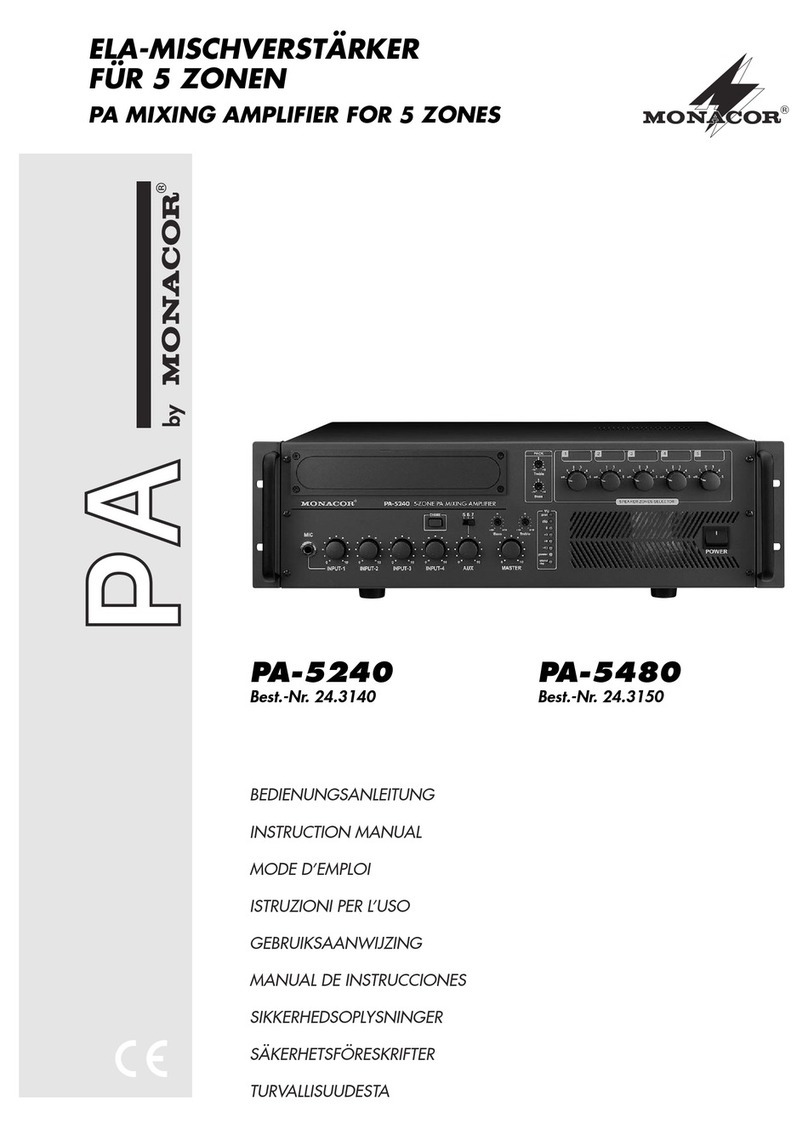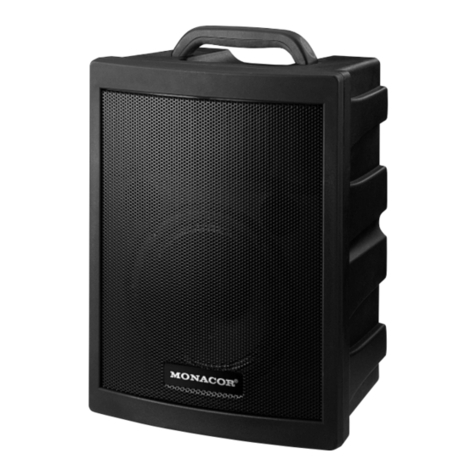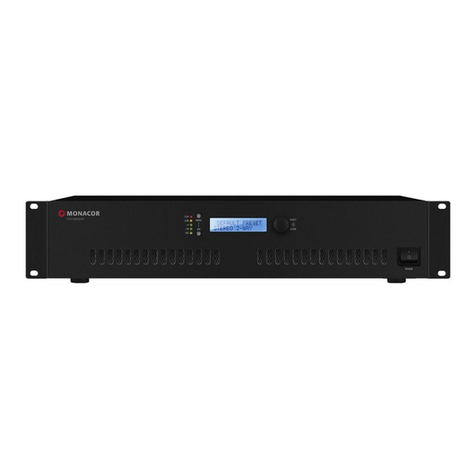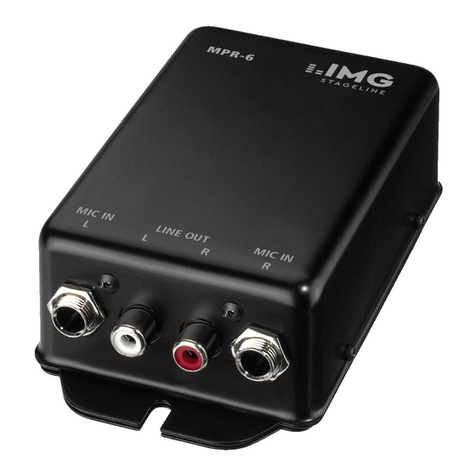MPR-1
Best.-Nr. 21.2010
wwwwww..iimmggssttaaggeelliinnee..ccoomm
Copyright©by MONACOR INTERNATIONAL GmbH & Co. KG, Bremen, Germany. All rights reserved. A-0284.99.01.08.2004
®
1-Kanal-Mikrofon-
Vorverstärker
1Einsatzmöglichkeiten
Mit dem MPR-1 kann ein Mikrofon an einen Line-Eingang
eines Audiogerätes (Mischpult, Aufnahmegerät etc.) an-
geschlossen werden. Für ein phantomgespeistes Mikro-
fon ist eine Phantomspeisung (30 V ) einschaltbar.
2Hinweise für den sicheren Gebrauch
Die Geräte (Vorverstärker und Netzgerät) entsprechen
der EMV-Richtlinie für elektromagnetische Verträglich-
keit 89/336/EWG. Das Netzgerät entspricht zusätzlich
der Niederspannungsrichtlinie 73/23/EWG.
●Verwenden Sie die Geräte nur im Innenbereich.
Schützen Sie sie vor Tropf- und Spritzwasser, hoher
Luftfeuchtigkeit und Hitze (zulässiger Einsatztempe-
raturbereich 0 – 40 °C).
●Verwenden Sie für die Reinigung nur ein trockenes,
weiches Tuch, niemals Chemikalien oder Wasser.
Achtung! Das Netzgerät wird mit lebensgefährlicher
Netzspannung (230 V~) versorgt. Nehmen Sie des-
halb nie selbst Eingriffe in diesem Gerät vor. Durch un-
sachgemäßes Vorgehen besteht die Gefahr eines
elektrischen Schlages.
●Werden die Geräte zweckentfremdet, nicht richtig
angeschlossen, falsch bedient oder nicht fachgerecht
repariert, kann keine Haftung für daraus resultie-
rende Sach- oder Personenschäden und keine
Garantie für die Geräte übernommen werden.
●Sollen die Geräte endgültig aus dem Betrieb genom-
men werden, übergeben Sie sie zur umweltgerechten
Entsorgung einem örtlichen Recyclingbetrieb.
3Inbetriebnahme
1) Das Mikrofon an die Klinkenbuchse INPUT UNBAL.
(5) oder an die XLR-Buchse INPUT BAL. (6) an-
schließen.
2) Die Line-Eingangsbuchse des Audiogerätes an die
Klinkenbuchse OUTPUT UNBAL. (8) oder an die
XLR-Buchse OUTPUT BAL. (7) anschließen. Vor-
rangig sollte die symmetrische XLR-Buchse verwen-
det werden, weil eine symmetrische Signalübertra-
gung die beste Störunterdrückung bietet (besonders
bei langen Verbindungskabeln).
3) Ist ein phantomgespeistes Mikrofon an der XLR-
Buchse (6) angeschlossen, die Phantomspeisung
mit der Taste PHANTOM (2) einschalten.
Vorsicht! Bei einem asymmetrisch beschalteten
Mikrofon darf die Phantomspeisung nicht einge-
schaltet sein. Das Mikrofon kann beschädigt werden.
4) Den Kleinspannungsstecker des Netzgerätes in die
Buchse „12 V “ (9) stecken und das Netzgerät in
eine Steckdose (230 V~/50 Hz). Der Verstärker ist
in Betrieb und die grüne Betriebsanzeige ON (1)
leuchtet.
5) Mit dem Regler GAIN (4) die Mikrofonlautstärke an
das angeschlossene Audiogerät anpassen. Leuchtet
die rote Übersteuerungsanzeige CLIP (3) auf, den
Regler GAIN entsprechend zurückdrehen.
6) Nach dem Betrieb das Netzgerät aus der Steckdose
ziehen, damit kein Strom unnötig verbraucht wird.
4Technische Daten
Frequenzbereich: . . . . . . . 10 – 30 000 Hz
Eingang XLR: . . . . . . . . . . 3,5 mV/10 kΩ, sym.
Eingang 6,3-mm-Klinke: . 16 mV/10 kΩ, asym.
Ausgangsspannung: . . . . 1 V
max. Verstärkung: . . . . . . 50 dB (XLR)
44 dB (6,3-mm-Klinke)
Störabstand: . . . . . . . . . . > 58 dB
Klirrfaktor: . . . . . . . . . . . . < 0,1 %
Stromversorgung: . . . . . . 12 V /150 mA über bei-
liegendes Netzgerät an
230 V~/50Hz/3VA
Laut Angaben des Herstellers. Änderungen vorbehalten.
1-Channel Microphone
Preamplifier
1Applications
The MPR-1 allows to connect a microphone to a line
input of an audio unit (mixer, recording unit, etc.). For
a phantom-powered microphone, a phantom power
(30 V ) can be switched on.
2Safety Notes
The units (preamplifier and power supply unit) corre-
spond to the directive 89/336/EEC for electromagnetic
compatibility. The power supply unit additionally corre-
sponds to the low voltage directive 73/23/EEC.
●The units are suitable for indoor use only. Protect
them against dripping water and splash water, high
air humidity, and heat (admissible ambient tempera-
ture range 0 – 40 °C).
●For cleaning only use a dry, soft cloth, by no means
chemicals or water.
Attention! The power supply unit is supplied with
hazardous mains voltage (230 V~). Leave servicing to
skilled personnel only. Inexpert handling may cause an
electric shock hazard.
●No guarantee claims for the units and no liability for
any resulting personal damage or material damage
will be accepted if the units are used for other purpos-
es than originally intended, if they are not correctly
connected, operated, or not repaired in an expert way.
●If the units are to be put out of operation definitively,
take them to a local recycling plant for a disposal
which is not harmful to the environment.
3Setting into Operation
1) Connect the microphone to the 6.3 mm jack INPUT
UNBAL. (5) or to the XLR jack INPUT BAL. (6).
2) Connect the line input jack of the audio unit to the
6.3 mm jack OUTPUT UNBAL. (8) or to the XLR jack
OUTPUT BAL. (7). The balanced XLR jack should be
given priority because a balanced signal transmis-
sion offers the best noise suppression (especially in
case of long connection cables).
3) If a phantom-powered microphone is connected to
the XLR jack (6), switch on the phantom power with
the button PHANTOM (2).
4) Connect the low voltage plug of the power supply unit
to the jack “12 V ” (9) and the power supply unit to
Caution! In case of an unbalanced microphone,
the phantom power must not be switched on. The
microphone may be damaged.
a mains socket (230 V~/50 Hz). The amplifier is in
operation and the green power LED ON (1) lights up.
5) With the control GAIN (4) match the microphone
volume to the connected audio unit. If the red over-
load LED CLIP (3) lights up, turn back the control
GAIN correspondingly.
6) After operation disconnect the power supply unit
from the mains socket so that no current is unneces-
sarily consumed.
4Specifications
Frequency range: . . . . . . . 10 – 30 000 Hz
Input XLR: . . . . . . . . . . . . 3.5 mV/10 kΩ, bal.
Input 6.3 mm connector: . 16 mV/10 kΩ, unbal.
Output voltage: . . . . . . . . 1 V
Max. gain: . . . . . . . . . . . . 50 dB (XLR),
44 dB (6.3 mm connector)
S/N ratio: . . . . . . . . . . . . . > 58 dB
THD: . . . . . . . . . . . . . . . . < 0.1 %
Power supply: . . . . . . . . . 12 V /150 mA via sup-
plied power supply unit
connected to
230 V~/50Hz/3VA
According to the manufacturer.
Subject to technical modification.
Préamplificateur
micro 1 canal
1Possibilités d’utilisation
Avec le MPR-1, un microphone peut être relié à une en-
trée ligne d’un appareil audio (table de mixage, enregis-
treur etc.). Une alimentation fantôme (30 V ) peut être
commutée pour un microphone à alimentation fantôme.
2Conseils d’utilisation et de sécurité
Les appareils (préamplificateur et bloc secteur) répondent
à la norme européenne 89/336/CEE, relative à la compa-
tibilité électromagnétique. Le bloc secteur répond en plus
à la directive 73/23/CEE sur les appareils basse tension.
●Les appareils ne sont conçus que pour une utilisation
en intérieur. Protégez-les des projections d’eau et
éclaboussures, d’une humidité élevée et de la cha-
leur (plage de température de fonctionnement auto-
risée 0 – 40 °C).
●Pour les nettoyer, utilisez uniquement un chiffon sec
et doux, en aucun cas de produits chimiques ou d’eau.
●Nous déclinons toute responsabilité en cas de dom-
Attention!Le bloc secteur est alimenté par une tension
dangereuse 230 V~. Ne touchez jamais l’intérieur de
l’appareil, vous pourriez subir une décharge électrique.
mages matériels ou corporels résultants si les
appareils sont utilisés dans un but autre que celui
pour lequel ils ont été conçus, s’ils ne sont pas cor-
rectement branchés, utilisés ou s’ils ne sont pas
réparés par une personne habilitée ; en outre, la
garantie deviendrait caduque.
●Lorsque les appareils sont définitivement retirés du
circuit de distribution, vous devez les déposer dans
une usine de recyclage adaptée pour contribuer à
leur élimination non polluante.
3Fonctionnement
1) Reliez le microphone à la prise jack INPUT UNBAL.
(5) ou à la prise XLR INPUT BAL. (6).
2) Reliez la prise d’entrée ligne de l’appareil audio à la
prise jack OUTPUT UNBAL. (8) ou à la prise XLR
OUTPUT BAL. (7). Prioritairement, la prise XLR sy-
métrique devrait être utilisée car une transmission
symétrique de signal propose la meilleure élimina-
tion des interférences (particulièrement pour des
câbles de liaison longs).
3) Si un micro à une alimentation fantôme est relié à la
prise XLR (6), allumez l’alimentation fantôme avec la
touche PHANTOM (2).
Attention ! Pour un micro asymétrique, l’alimenta-
tion fantôme ne doit pas être allumée. Le micro peut
être endommagé.
4) Mettez la fiche basse tension du bloc secteur dans la
prise “12 V ” (9) et reliez le bloc secteur à une prise
secteur 230 V~/50 Hz. L’amplificateur est en fonction,
la LED verte ON (1), témoin de fonctionnement, brille.
5) Avec le réglage GAIN (4), adaptez le volume du
micro à l’appareil audio relié. Si la LED rouge CLIP
(3), témoin d’écrêtage, brille, tournez le réglage
GAIN en fonction dans l’autre sens.
6) Après le fonctionnement, débranchez le bloc secteur
de la prise secteur pour éviter toute consommation
inutile de courant.
4Caractéristiques techniques
Bande passante : . . . . . . . 10 – 30 000 Hz
Entrée XLR : . . . . . . . . . . 3,5 mV/10 kΩ, sym.
Entrée jack 6,35 : . . . . . . . 16 mV/10 kΩ, asym.
Tension de sortie : . . . . . . 1 V
Amplification maximale : . 50 dB (XLR),
44 dB (jack 6,35)
Rapport signal sur bruit : . > 58 dB
Taux de distorsion : . . . . . < 0,1 %
Alimentation : . . . . . . . . . . 12 V /150 mA par bloc
secteur livré branché à
230 V~/50Hz/3VA
D’après les données du constructeur.
Tout droit de modification réservé.
UNBAL.BAL.BAL.UNBAL.

